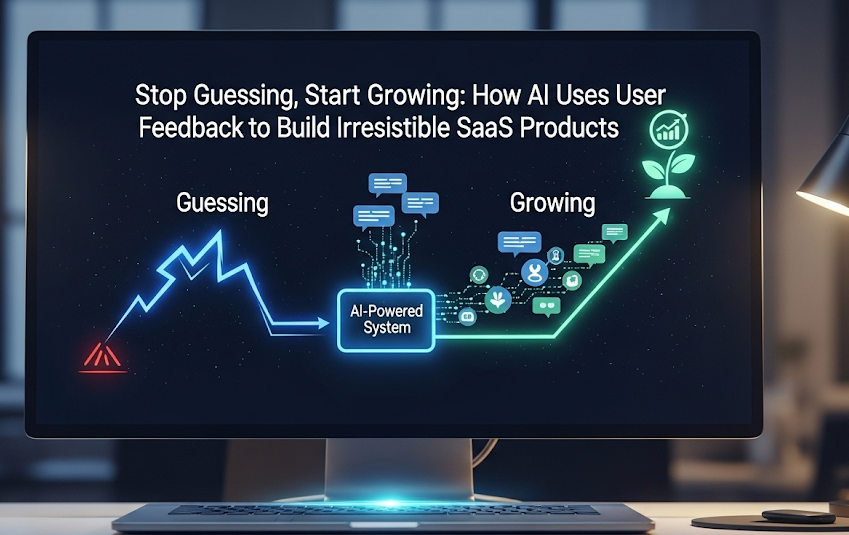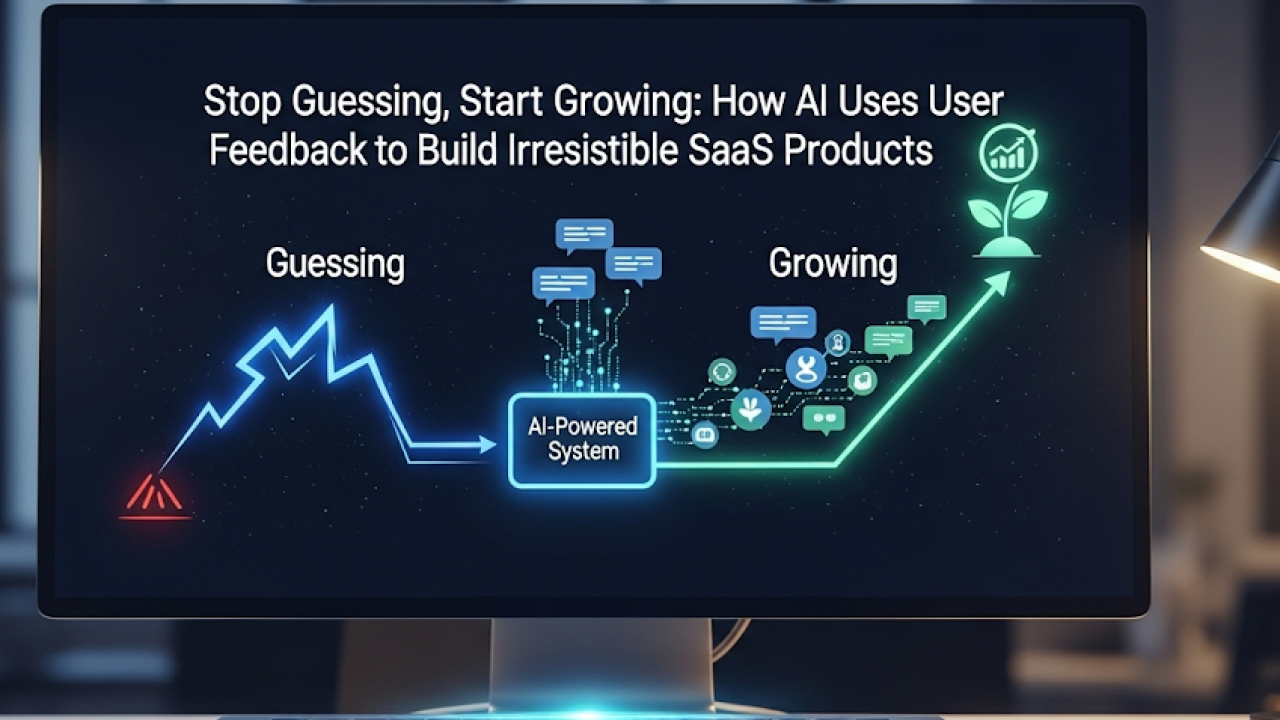The User Feedback Puzzle: Why It’s Hard (and Why It Matters So Much)

The Goldmine of User Insights: Why Every Click and Comment Counts
Every user interaction with your SaaS product holds immense value. Think of each click, scroll, and comment as a tiny piece of a larger puzzle. This includes explicit feedback like survey responses and app store reviews. It also covers implicit data, such as how long a user stays on a page or which features they frequently use. “Understanding these digital breadcrumbs is crucial for uncovering genuine user needs and pain points.” They reveal where users struggle and what they love. This rich stream of information is a true goldmine of user insights.
Leveraging this detailed user behavior data allows product teams to move beyond mere guesswork. Instead of making assumptions, decisions are rooted in evidence. This data directly informs feature prioritization and design choices. For example, if many users drop off at a specific step, that signals an area needing urgent improvement. “By acting on these insights, companies can refine their offerings and build features that users genuinely want and need.” Ultimately, this commitment to continuous product improvement ensures the creation of irresistible SaaS products that foster loyalty and drive growth.
Launch Your App Today
Ready to launch? Skip the tech stress. Describe, Build, Launch in three simple steps.
BuildOverwhelmed by Opinions: The Challenge of Manual Feedback Analysis
Modern SaaS companies face a deluge of user feedback daily. This feedback pours in from countless channels: support tickets, social media comments, in-app surveys, review sites, and direct emails. Imagine a small team trying to manually sift through thousands of these messages each week. It’s not just a lot of data; it’s often unstructured, inconsistent, and sometimes contradictory. “Manually analyzing this immense volume of diverse feedback is a nearly impossible task for human teams.” This overwhelming flood makes it incredibly difficult to identify common pain points, emerging trends, or critical bug reports efficiently.
The challenge deepens because customer feedback isn’t neatly categorized. You might find detailed feature requests mixed with simple “love it” messages, urgent bug reports, or nuanced usability suggestions. Each piece needs context and sentiment analysis to truly understand its value. Trying to sort, categorize, and prioritize these insights manually consumes vast amounts of time and resources, pulling product teams away from development. Consequently, crucial customer insights can easily get overlooked or misjudged, leading to missed opportunities for product improvement and user satisfaction.
Beyond the Buzz: How AI Steps In to Transform Feedback into Action
Manually sifting through mountains of user feedback is slow, labor-intensive, and prone to human bias. As SaaS products scale, the sheer volume of reviews, support tickets, and survey responses quickly becomes unmanageable for human teams. This is precisely where AI steps in, transforming a chaotic deluge of information into structured, actionable insights. It processes vast amounts of unstructured data quickly, identifying subtle patterns and connections that human analysts often miss, proving essential for truly understanding your user base.
Advanced AI algorithms, powered by natural language processing (NLP), analyze feedback text to gauge user sentiment—identifying if users are pleased, frustrated, or neutral. It then automatically clusters similar feedback topics, such as all requests for a specific feature or complaints about a particular bug. “These capabilities allow product teams to pinpoint critical issues and emerging needs with unparalleled speed and accuracy.” Furthermore, AI can even help predict future user behavior and prioritize product development, ensuring the team builds what users genuinely want, when they want it, leading to more irresistible SaaS products.
Decoding the Digital Voice: AI’s Superpowers for User Feedback

Natural Language Processing (NLP): Understanding What Users *Really* Mean
Natural Language Processing (NLP) gives AI the incredible power to truly understand human language. It moves far beyond simply counting keywords or basic word matching. NLP meticulously analyzes vast amounts of diverse user feedback, transforming unstructured text from reviews, survey responses, and support tickets into actionable, structured data. This powerful technology deciphers the intricate nuances of human expression. It helps SaaS products gain deeper, more precise insights by interpreting context, sarcasm, and even subtle emotional cues within user comments.
Beyond just understanding the words, NLP performs advanced sentiment analysis. This accurately tells us if specific feedback is positive, negative, or neutral. Crucially, it also identifies underlying emotions and user intent behind the comments. For example, NLP can automatically group thousands of user comments about a ‘slow loading time’ and pinpoint specific areas or features causing that frustration. This reveals critical key themes and emerging pain points that might otherwise go unnoticed in vast datasets. “NLP ensures that every piece of customer feedback is not just heard, but profoundly understood,” empowering teams to prioritize improvements and build more irresistible SaaS products aligned with genuine user needs.
Sentiment Analysis: Gauging the Mood Behind the Message
Sentiment analysis is a powerful AI superpower that deciphers the emotional tone of user feedback. It moves beyond simply logging complaints, intelligently analyzing text from reviews, support tickets, and social media to identify positive, negative, or neutral sentiment. “This allows SaaS companies to understand the *feeling* behind a customer’s words, not just the words themselves,” providing crucial insight into customer emotions and their overall product experience.
By understanding these emotions, teams can quickly pinpoint areas causing frustration or highlight beloved features. For instance, a surge in negative sentiment around a specific UI element signals an urgent need for improvement, while positive trends validate successful updates. This data-driven approach enables product improvements that genuinely resonate with users, transforming raw feedback into actionable intelligence for growth.
Predictive Analytics: Anticipating User Needs Before They Ask
AI uses predictive analytics to understand user behavior deeply. It continuously sifts through vast data. This includes past interactions, support requests, and in-app activity patterns. This advanced analysis uncovers subtle trends and recurring needs. “The primary goal is to accurately forecast what users will want or need next.” This allows SaaS products to move from a reactive stance to a proactive development cycle.
“This AI-powered foresight fundamentally transforms how SaaS products evolve.” Instead of waiting for explicit user feedback, AI proactively suggests new features. It also identifies potential friction points *before* they impact users. For example, if many users manually export reports, AI might predict the need for an automated dashboard. Salesforce, for instance, uses AI to predict customer churn risks. It then recommends proactive engagements. “By anticipating these user needs, companies build SaaS products that feel incredibly intuitive and indispensable.” This strategy significantly boosts customer satisfaction and dramatically improves user retention.
Topic Modeling & Clustering: Finding Patterns in the Noise
Manually sifting through thousands of customer comments is incredibly time-consuming. This is where AI’s topic modeling shines. It expertly cuts through vast amounts of unstructured user feedback. Think of reviews, surveys, and support tickets. This powerful AI technique automatically identifies and extracts recurring themes and subjects. “It reveals the core topics users are discussing, turning a flood of words into actionable insights.” For example, it might quickly highlight conversations around ‘slow load times’ or ‘missing mobile features’, providing a clear focus for product teams.
Furthermore, AI utilizes clustering to group similar feedback together. Even if users phrase issues differently, AI understands their common intent. This means all comments about ‘laggy performance’ or ‘difficulty with onboarding’ are neatly categorized. “This capability helps SaaS companies see the true scale of a problem or the widespread demand for a new feature.” Such automated pattern recognition allows businesses to move beyond anecdotes. They can then prioritize development efforts based on concrete, data-driven trends, not just guesses.
From Raw Data to Raving Fans: How AI Fuels Better SaaS Products

Prioritizing Features with Precision: What Users Want, When They Want It
Traditional feature prioritization often relies on guesswork. Product teams may struggle to sift through countless requests. AI revolutionizes this process. It rapidly analyzes vast quantities of user feedback. This includes support tickets, app store reviews, social media discussions, and survey results. AI identifies common pain points and emerging trends. It accurately pinpoints what users *truly* need from their SaaS products. This deep analysis helps uncover unspoken desires, moving beyond surface-level suggestions. “AI transforms scattered user opinions into clear, actionable insights.”
With these precise insights, AI-driven prioritization becomes a strategic advantage. AI models predict which features will deliver the highest value. They consider user sentiment, engagement metrics, and market demand. This allows SaaS product development teams to allocate resources with confidence. They build features that address critical needs exactly when users want them. “This data-driven method maximizes customer satisfaction and accelerates product adoption.” It significantly reduces the risk of building unwanted features.
Spotting Bugs and UX Glitches Faster Than Ever
AI tools are revolutionizing how SaaS products identify issues. They continuously analyze vast amounts of user feedback and behavioral data. This includes session recordings, click patterns, and detailed error logs. AI can quickly detect unusual activity or recurring patterns. “These patterns often signal a bug or a subtle UX glitch before it impacts many users.” It pinpoints exactly where users struggle or encounter unexpected behavior.
This capability dramatically speeds up the debugging process. Development teams no longer rely solely on users manually reporting issues. Instead, AI highlights potential problems, often proactively. For instance, an AI might flag a specific button that many users repeatedly click without the expected outcome. This instantly indicates a UX glitch needing attention. It also identifies performance bottlenecks or server errors that silently degrade the user experience. “Faster resolution of these problems leads directly to higher customer satisfaction and a more reliable SaaS product.” This approach transforms reactive fixes into proactive improvements.
Personalized User Experiences: Tailoring SaaS to Individual Needs
AI transforms generic software into highly personalized user experiences. It analyzes vast amounts of user feedback, behavior patterns, and historical data. This lets SaaS products understand individual preferences. For example, AI can recommend specific features. It might also adjust the interface based on a user’s typical workflow. “This intelligent tailoring SaaS ensures the product feels intuitive and directly relevant to individual needs.” This greatly boosts user engagement and satisfaction.
This level of customization moves beyond basic settings. Think of Netflix, which uses AI to suggest movies based on your viewing history. Similarly, AI helps tailor SaaS for professional users. It might customize a content management system to a writer’s preferred templates. Or it could adapt project management tools to a team’s specific workflow. “This deep personalization reduces friction and makes users feel truly understood.” This approach cultivates loyal customers. They see the SaaS product as indispensable, not just another tool. This greatly enhances customer retention and advocacy.
Iterating Rapidly: Building a Feedback-Driven Development Loop
Traditionally, analyzing vast amounts of user feedback was a slow, manual task. Teams spent countless hours sifting through surveys, reviews, and support tickets. This created significant bottlenecks in product development. “AI changes this entirely by instantly processing huge, unstructured data sets.” It uses natural language processing to identify common pain points, emerging trends, and pressing feature requests. This allows development teams to understand user needs in minutes, not weeks. They can then prioritize and plan changes with far greater accuracy and speed.
This accelerated analysis fuels a truly feedback-driven development loop. AI-powered insights empower engineers to build, test, and deploy targeted feature updates with unprecedented speed. For example, many leading SaaS companies, like GitHub for its Copilot feature, continuously integrate user interaction data and feedback to refine functionality. “This rapid iteration ensures that SaaS products evolve dynamically, always aligned with user expectations.” Products become more intuitive and valuable much faster. The outcome is superior customer satisfaction and a stronger market position.
Success Stories: When AI Meets User Feedback in the Wild

Startup Spotlight: How AI Helped a New SaaS Find Its Niche
Consider ‘FeatureFlow’, a nascent SaaS platform aiming to streamline project management. Initially, they offered a wide array of tools, but user engagement was low. They struggled to identify their core value proposition. FeatureFlow then deployed an AI-powered feedback analysis system. This system constantly monitored in-app usage data, support chat logs, and survey responses.
The AI quickly identified a surprising trend. Users were heavily utilizing a small, specific feature for advanced task prioritization. They were also frequently requesting integrations related to this niche. The AI surfaced clear data showing an underserved market segment desperate for a dedicated solution. FeatureFlow pivoted, refining its product to focus solely on AI-driven task prioritization for agile teams. “”This decisive shift, guided by AI and user feedback, transformed FeatureFlow from a generic tool.”” “”They became a market leader in their specialized niche.”” They saw a 300% increase in sign-ups within six months.
Enterprise Evolution: Scaling Feedback Insights with AI
Large enterprises grapple with an immense volume of user feedback daily. Manually analyzing thousands of support tickets, survey responses, and social media comments is simply impossible at this scale. This is where AI excels in feedback management. AI-powered platforms ingest and process vast, unstructured datasets automatically. They quickly identify patterns, sentiment, and emerging trends across all channels. This capability provides a unified view of user sentiment, crucial for giant organizations like a global CRM provider handling millions of interactions. It makes their feedback loop truly scalable and manageable.
Beyond just organizing, AI actively categorizes and prioritizes feedback. It uses sophisticated algorithms to rank feature requests based on user impact and frequency. AI even anticipates future user needs, surfacing subtle issues that human analysts might overlook in the noise. “This ensures product teams within large enterprises can focus their efforts on what genuinely matters, building user-centric products that solve real problems.” This leads to faster, more data-driven decisions and significantly improves customer satisfaction at scale. It helps them evolve their offerings continuously and efficiently.
Measuring the ROI: The Tangible Benefits of AI-Driven Feedback Loops
AI systems excel at converting raw, qualitative user feedback into precise, quantifiable insights. This approach moves companies beyond simple guesswork. Instead, it provides actionable data for product development. “You can now accurately measure how specific user suggestions directly boost engagement and improve user retention.” This precision leads to significantly faster iteration cycles. It also helps reduce overall development costs by ensuring resources are spent on features users genuinely value.
The Return on Investment (ROI) from implementing AI-driven feedback loops is profoundly tangible. SaaS companies consistently report clear improvements in customer satisfaction scores. This often translates directly into significantly reduced churn rates, a vital metric for sustained growth. For example, consider a well-known project management tool. They utilized AI to pinpoint critical usability issues. Addressing these, based on the AI’s insights, resulted in a verifiable 18% increase in weekly active users. It also led to a 10% uplift in premium subscriptions in just two months. “Investing in AI for deep feedback analysis quickly demonstrates its financial benefits and fosters stronger product-market fit.”
Beyond Metrics: Building User Trust and Loyalty
AI’s true power in SaaS goes beyond simple metrics. While quantitative data shows *what* users do, AI dives into *why*. It analyzes qualitative feedback using advanced sentiment analysis and natural language processing. This pinpoints specific user pain points and frustrations expressed in support tickets or product forums. “Understanding the human emotion behind the data is crucial for truly empathetic product development.” This approach helps teams build features that genuinely resonate, moving past mere numerical optimization.
This deep understanding fosters genuine user trust and long-term user loyalty. Users feel valued when their nuanced feedback directly leads to meaningful product improvements. For instance, AI might identify a common workflow frustration from many user comments, even subtle ones. Addressing this specific issue builds a much stronger connection. Users become advocates, sharing positive experiences. Here, AI uses user feedback to cultivate a deeply engaged user base, not just to fix simple bugs.
Navigating the AI Frontier: Best Practices and What’s Next

Implementing AI: Getting Started with Feedback Automation
Starting with AI feedback automation doesn’t require a complete overhaul. Begin by identifying a specific, manageable pain point. Perhaps you struggle to categorize a high volume of support tickets or glean insights from app store reviews. Tools like natural language processing (NLP) are perfect for this. They can automatically sort feedback by sentiment (positive, negative, neutral) or topic. “Even simple tools, like integrating AI-powered survey analysis platforms, can deliver immediate value.” This initial step allows your team to focus on actionable insights instead of manual data sifting.
Once you have your initial system running, it’s time to iterate and refine. Monitor the accuracy of your AI models. Do they correctly identify urgent issues or recurring feature requests? Use the AI’s output to make tangible improvements to your SaaS product. This creates a powerful feedback loop. “Continuously feeding new data into your AI helps it learn and become even more precise.” Consider integrating AI with other tools, like your CRM or project management software, for a truly unified feedback system. This strategic approach moves you from guessing to data-driven decision-making.
The Human Touch: Blending AI Insights with Empathy and Intuition
AI offers powerful data, highlighting user behaviors and preferences. However, “pure data lacks the nuances of human experience.” It cannot fully understand emotional triggers or unarticulated needs. This is where the human touch becomes essential. Expert product managers use AI to identify patterns. They then apply their intuition to interpret the ‘why’ behind the data. This blend creates a truly holistic view. It enriches the understanding of user journeys.
Consider the example of TikTok’s success. While its algorithm is brilliant, human curators and trend spotters also shape content. They ensure cultural relevance and emotional resonance. Teams must integrate AI insights with deep empathy for their users. This means stepping into the user’s shoes. It helps anticipate future needs that data alone might not reveal. “Ultimately, the most irresistible SaaS products are built on a foundation of both intelligent data and profound human understanding.” This balance drives genuine, user-centric innovation.
Ethical AI and Data Privacy: Building Trust with Your Users
For AI-powered SaaS products, data privacy is paramount. Users are increasingly aware of their personal information and how it’s used. “Explicitly communicate your data handling policies to build user trust.” This means clear, easy-to-understand terms, not hidden legalese. Adhering to regulations like GDPR or CCPA isn’t just a legal requirement; it’s a commitment to ethical AI. Prioritizing transparency in data collection and usage demonstrates respect for your users. It shows that you value their privacy as much as their feedback.
Beyond privacy, ethical AI demands responsible development. AI systems must be designed to be fair and unbiased. Consider the data used to train your AI; biased datasets can lead to discriminatory outcomes in your SaaS products. Actively audit your AI models for fairness and equity. “Proactive measures ensure that your AI serves all users equitably, preventing harm and fostering genuine loyalty.” This commitment to fairness is crucial for long-term user satisfaction. Ultimately, building trust with ethical AI practices transforms users into loyal advocates.
The Road Ahead: AI, AGI, and the Future of SaaS Development
The road from today’s specialized AI to Artificial General Intelligence (AGI) is dynamic and exciting. Currently, AI profoundly enhances SaaS development by automating critical functions. These include code generation, bug detection, and personalizing user experiences. “Such advancements empower development teams, enabling rapid innovation and immediate response to user feedback.” While true AGI, capable of any human intellectual task, remains a distant prospect, advanced AI models are rapidly expanding their capabilities. They constantly redefine what’s achievable in product iteration and customer engagement.
Looking ahead, the potential emergence of AGI would fundamentally reshape SaaS product development. Imagine AI autonomously designing complex features based on evolving user needs, even predicting future market shifts with unparalleled accuracy. This scenario transcends mere efficiency, representing a new development paradigm. “Human creativity, strategic oversight, and ethical guidance will remain absolutely vital as AI technology advances.” We will continue to guide these intelligent systems, crafting more intuitive and indispensable SaaS solutions while always prioritizing user-centric design and feedback loops.
Launch Your App Today
Ready to launch? Skip the tech stress. Describe, Build, Launch in three simple steps.
Build




